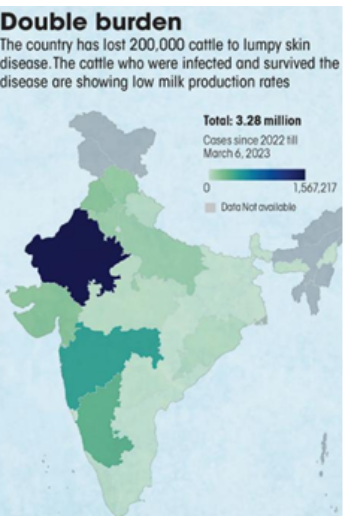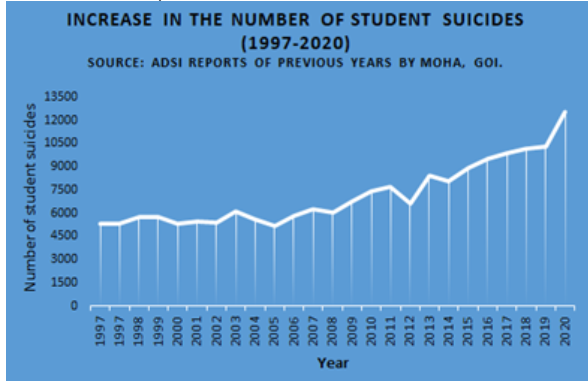Tuesday, 3rd October 2023
Concerns of Using Aadhaar in Welfare Schemes
In News: A recent Moody’s report, ‘Decentralised Finance and Digital Assets’, highlights the security and privacy vulnerabilities of centralized biometric systems based identities like Aadhaar and advocates for decentralized digital identity systems instead of centralized biometric systems.
About Aadhaar:
- Aadhaar is a unique identification number given to all Indian residents by the Unique Identification Authority of India (UIDAI).
- It serves as proof of identity and address (not citizenship) and is linked to an individual’s biometric and demographic information.
- Aadhaar enrolment involves the collection of demographic details of individuals along with their biometric fingerprints and iris scans, as they are considered to be unique identifiers of individuals. These details are stored in the Aadhaar database.
Rationale for Aadhaar:
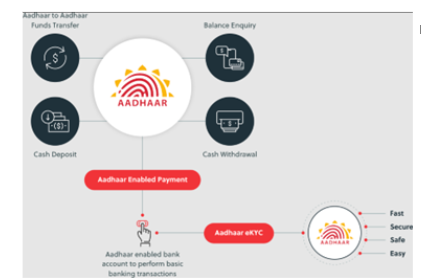
- The objectives of UIDAI were to ensure that all residents have a unique ID and to curb corruption in accessing welfare programs by eliminating “ghost” and “fake” individuals.
- An individual is called a ‘ghost’ if they access rations in the name of a dead person, and a ‘fake’ if they access rations even though they are not officially entitled to it.
- The government favours Aadhaar for several other government-to-citizen cash transfer programmes and claims that it leads to substantial savings in welfare schemes, as it removes ghosts and duplicates.
Utility of Aadhaar:
- Aadhaar as financial address of individual: Aadhaar acts as the financial address of the individual and after linking it with their job card and bank account payments for various services like MNREGA wages, subsidies, etc. can be directly remitted to the account of the individual.
- Aadhaar-enabled Payment System (AePS): Individuals can withdraw money from their Aadhaar-linked bank account through AePS. Cash can be withdrawn through private banking kiosks or private banking correspondents who use their point of sale machines to authenticate individuals using their biometrics
- Seeding of Aadhaar in the MGNREGS database: Seeding has been done without requiring the worker to authenticate using their biometrics. Payment to workers under the scheme is also made by directly crediting money in their account without requiring authentication of their biometrics.
- Improved targeting: Aadhaar can help to ensure that government benefits are targeted to the intended beneficiaries and that leakages and duplication are reduced.
Concerns regarding the use of Aadhaar in welfare schemes:
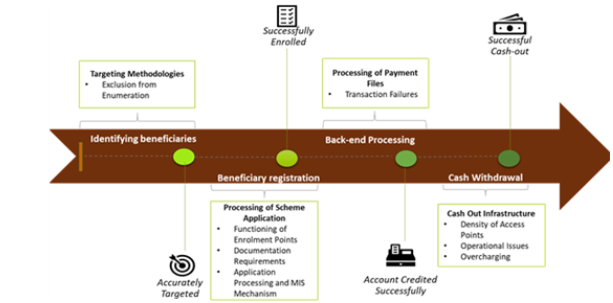
- Failure in curbing quantity frauds: several organizations have pointed towards quantity fraud being the main type of corruption. Aadhaar has no role in either detecting or preventing this fraud.
- Biometric authentication failure: Rural areas witness frequent authentication failure due to lack of reliable internet, fading fingerprints among daily wage workers, lack of phone connectivity to get an OTP, etc. leading to denials.
- People have to make multiple trips to ration shops, to authenticate with no guarantee that the authentication will work.
- Older women, people with disabilities, etc. are more prone to hardships and exclusions due to such stringent biometric authentication requirements.
- Payment failures: In Aadhaar-based payments, errors in any step result in payment failures. Different spellings in the job card and in the Aadhaar database can result in authentication failures.
- Diversion of wages: Lack of awareness and coercion by financial institutions to link Aadhaar to bank accounts without consent results in wages getting diverted to some other account without the worker’s knowledge. For example, Aadhaar payments of people got redirected to Airtel wallets.
- Misdirected payments: Misdirected payments through Aadhaar are difficult to detect and are nearly impossible to resolve. These happen when one person’s Aadhaar number gets linked to somebody else’s bank account.
- Exclusions as constitutional violation: Exclusions from social welfare services resulting from accessibility issues due to Aadhaar are often considered as constitutional violations.
- Security concerns:
- Banking correspondents using the AePS operate without any accountability framework.
- Multiple biometric authentication: Some banking correspondents ask individuals to biometrically authenticate multiple times. Each authentication gives access to the banking correspondents to operate the individual’s bank account. Using AePS, money from workers’ accounts have been withdrawn or that they have been signed up for government insurance programmes without their knowledge.
- Scams: Aadhaar related scams like those witnessed in Rs10 crore scholarship scam in Jharkhand is also witnessed.
- Deletion of MNREGA job cards: Job cards of several alive and active rural workers have been deleted on grounds that they are dead or “ghosts.”

- Linking Aadhaar with other services: The government has pushed for Aadhaar in other matters such as linking voter IDs with Aadhaar. However, critics are apprehensive that this might not be beneficial based on their prior experiences.
Source: The concerns of using Aadhaar in welfare schemes | Explained - The Hindu.
India Ageing Report 2023 - Edukemy Current Affairs
Why in News: Recently, the United Nations Population Fund (UNPF), India, has released the “2023 India Ageing Report”, highlighting the rapidly growing elderly population in India.
Key Highlights of the Report:
- Elderly Population Growth:
- With the decadal growth rate of the elderly population of India currently estimated to be at 41%.
- The percentage of the elderly population in the country is projected to double to over 20% of the total population by 2050.
- The elderly population will have surpassed the population of children (aged 0 to 15 years) in the country by 2046.
- Impact of Poverty:
- More than 40% of the elderly in India are in the poorest wealth quintile. Poverty among the elderly is a concern, affecting their quality of life and healthcare utilization.
- About 18.7% of them are living without an income.
- Life Expectancy of Women: In comparison to males, women have a higher life expectancy between the ages of 60 and 80, which varies across the states and union territories.
- Sex Ratio:
- Poverty is inherently gendered in old age when older women are more likely to be widowed, living alone, with no income and with fewer assets of their own, and fully dependent on family for support.
- Between 2011 and 2021, the sex ratio increased in India as a whole and across all regions, barring the Union Territories and western India.
- Regional Variations:
- There are significant inter-State variations in the elderly population and their growth rates.
- Most States in the southern region and select northern States such as Himachal Pradesh and Punjab reported a higher share of the elderly population than the national average in 2021
Recommendations of the Report:
- By integrating pertinent questions in data collecting activities such as the National Sample Survey, the National Family Health Survey, and the Census of India, the absence of reliable data on a variety of topics relating to the elderly can be addressed.
- Increase awareness about the elderly initiatives already in place and bring all Old Age Homes under regulatory scrutiny. Promote the formation and operation of elderly self-help groups.
- Be sure to emphasise the value of elders residing in multigenerational homes. Promote legislation that makes this way of life easier and more comfortable.
- Encourage in situ (at home) ageing as much as possible by creating short-term care facilities like creches or day-care facilities.

Palm-Oil Production - Edukemy Current Affairs
Why in News: Recently, Malaysia signed a deal to double palm oil exports to China annually is a move to offset potential revenue losses from the EU’s ban on commodities that are linked to deforestation.
Background of the Deal:
- The European Union (EU) intends to phase out imports of palm oil-based biofuel by 2030. The EU Deforestation-Free Regulation (EUDR) adopted in Brussels earlier this year will impose considerable non-tariff barriers on palm oil exporters to the EU countries.
- The two largest producers of palm oil in the world, Malaysia and Indonesia, have responded strongly to what they view as European protectionism.
- The regulation requires firms to ensure that the product exported to the EU has been grown on land that has not been deforested after December 31, 2020.
- The regulation is not WTO (World Trade Organization) compliant and is a non-tariff barrier.
Malaysia’s Response:
- Malaysia signed a deal with China earlier this month at the China-ASEAN Expo regarding the investment of €3.9 billion ($4.1 billion).
- Because much of Indonesia’s palm oil sector is under Malaysian ownership, a shift by Malaysia towards Chinese markets would also likely affect palm oil producers in Indonesia.
- The European Union remains a major consumer of palm oil globally. Considering the EU’s vast consumer base and its affluent middle class, it’s anticipated that this market will remain attractive to exporters
Palm Oil Production:
- It is an edible vegetable oil derived from the mesocarp (reddish pulp) of the fruit of the oil palms.
- It is used as cooking oil, and in everything from cosmetics, processed foods, cakes, chocolates, spreads, soaps, shampoo, and cleaning products to biofuel.
- The use of crude palm oil in making biodiesel is being branded as ‘green diesel’.
- Indonesia and Malaysia together account for almost 90% of the global palm oil production.
- India is the biggest importer of palm oil, which makes up 40% of its vegetable oil consumption. India meets half of its annual need for 8.3 MT of palm oil from Indonesia.
- In 2021, India unveiled the National Mission on Edible Oil-Oil Palm to boost India’s domestic palm oil production.
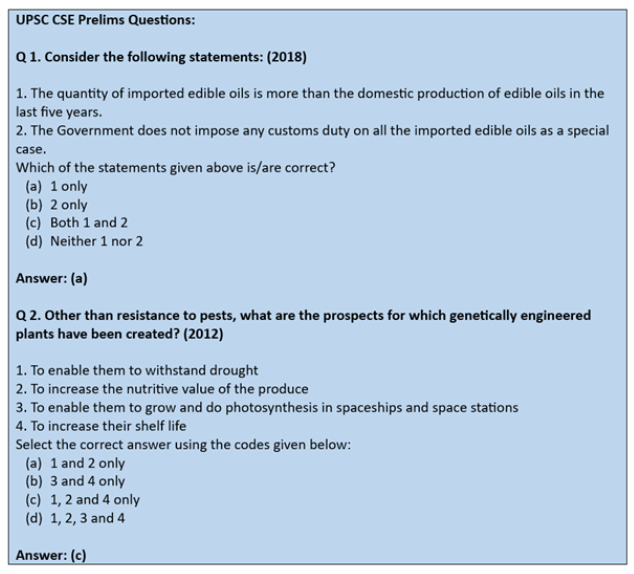
Aadhaar Linkage with the Electoral Roll is Voluntary
Why in news? Recently, the Election Commission (EC) has told the Supreme Court that it is not mandatory to provide Aadhaar numbers for linking with the electoral roll.
About:
- SC's Decision: SC recorded that the submission of Aadhaar numbers is not mandatory according to Rule 26-B of the Registration of Electors (Amendment) Rules 2022.
- Rule 26B, dealing with “special provision for providing Aadhaar number by existing electors”, states that “every person whose name is listed in the roll may intimate his Aadhaar number to the registration officer in Form 6B in accordance with sub-section (5) of Section 23 of the Representation of the People Act, 1950.
- Form 6B is a letter of information that contains a person's Aadhaar number for the purpose of electoral roll authentication.
- ECI's Response: The EC is considering making appropriate clarificatory changes to the forms related to the Aadhaar linkage, indicating its intent to clarify the voluntary nature of the Aadhaar submission.
- This practice violated Articles 14 and 21 of the Constitution and could lead to the misuse of voters' personal data.
- The poll body informed the Bench that “nearly 66.23 crore Aadhaar numbers have already been uploaded in the process of finalizing electoral rolls”.
Rashtriya Vayoshri Yojana - Edukemy Current Affairs
Why in news? In an endeavor for empowering persons with disabilities and senior citizens of the country the Ministry of Social Justice and Empowerment, Government of India organized ‘Samajik Adhikarita Shivirs’ across 72 locations simultaneously across the country.
About:
- These camps aim to distribute various types of aid and assistive devices to over 12000 persons with disabilities and senior citizens under the Rashtriya Vayoshri Yojana.
Rashtriya Vayoshri Yojana:
- Rashtriya Vayoshri Yojana is scheme for providing Physical Aids and Assisted-living Devices for Senior citizens belonging to BPL category.
- It was launched in 2017 by the Ministry of Social Justice and Empowerment.
- This is a Central Sector Scheme, fully funded by the Central Government.
- The expenditure for implementation of the scheme is being met from the “Senior Citizens’ Welfare Fund”.
- The Scheme is being implemented by the Artificial Limbs Manufacturing Corporation (ALIMCO), a PSU under the Ministry of Social Justice and Empowerment
- Features:
- The scheme works by distributing free of cost devices, commensurate with the extent of disability or infirmity that is manifested among the eligible senior citizens.
- The devices supported under the scheme are: Walking sticks, Elbow crutches, Walkers/Crutches, Hearing Aids, Wheelchairs, Artificial Dentures and Spectacles.

-
- The scheme is expected to benefit over 5 lakh Senior Citizens across the country.
Pangolin - Edukemy Current Affairs
Why in news? Recently, Scientists discovered a new pangolin species named Manis Mysteria.
About:

- There are eight previously known species of pangolin — four found in Asia and four in Africa.
- This discovery marks the ninth known species of pangolin.
- Pangolins are among the most trafficked wild mammals globally.
- Pangolins have been poached for bushmeat, but in the last decade, their skins, scales, and whole bodies have been in high demand in countries like Vietnam, China, and the US. This has led to a decline in their populations.
- Pangolins are nocturnal and have the ability to swim.
- Pangolins feed mainly on termites but also eat ants and other insects.
- India is home to two species:
- Indian Pangolin (EN), found across the subcontinent.
- Chinese Pangolin (CR) is found across a larger area in south Asia.
- Both species are Listed in Schedule I of the Wildlife Protection Act, 1972.
- IUCN status:
- All eight pangolin species are protected under national and international laws.
- Critically Endangered - Philippine Pangolin, Sunda Pangolin, Chinese Pangolin.
- Vulnerable - Temminck's Pangolin.
- Endangered - Indian Pangolin, White-bellied Pangolin.
- Ecological Importance: They play a vital role in ecosystem management, mostly in aerating and adding moisture to the soil as well as the succession of plant communities through burrowing.
Manis Mysteria:
- This species bears similarities to the Asian branch of the pangolin family, known as Manis.
- The researchers gave it the name Manis Mysteria, in reference to its enigmatic nature.
- Origin - Most of the Asian pangolins are thought to have originated in South-East Asia.
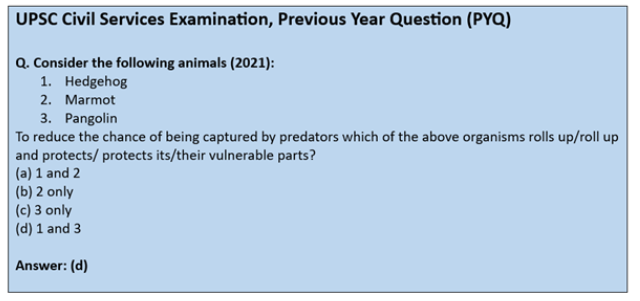
https://edition.cnn.com/2023/09/27/world/new-pangolin-species-discovery-scn/index.html
Policy Initiatives for Pharma Med Tech Sector
Why in news? Recently, Union Minister of Chemicals and Fertilisers and Minister of Health & Family Welfare launched the National Policy on Research and Development and Innovation in Pharma-MedTech Sector in India and Scheme for promotion of Research and Innovation in Pharma MedTech Sector (PRIP).
About:
National Policy on Research and Development and Innovation in Pharma-MedTech Sector:
- This policy aims to transform India’s pharmaceutical and medical technology industries from being cost-based to becoming value-based and innovation-driven.
- The policy aims to encourage R&D in pharmaceuticals, including traditional medicines & phytopharmaceuticals and medical devices.
- The policy acknowledged the need for greater emphasis on encouraging R&D, through indigenously developed cutting-edge products and technologies upon three focus areas, namely, strengthening the regulatory framework, incentivizing investments in innovation, and creating a facilitatory ecosystem for Innovation.
- The event will see active participation from other dignitaries, including policymakers, and experts from the healthcare sector along with representatives from academia, think tanks, industry, and media.
Scheme for Promotion of Research and Innovation in Pharma-MedTech Sector (PRIP):
- The PRIP scheme focuses on fostering innovation and transforming the MedTech sector into an innovation-driven powerhouse.
- It emphasizes high-quality research and innovation, aiming to shift the sector towards value and innovation-based approaches.
Components
-
- Component A - Strengthening the research infrastructure by establishment of seven centres of excellence at the National Institute of Pharmaceutical Education and Research (NIPER).
- Component B - Promoting research in Pharma’s 6 priority areas (like New Chemical Entities, Complex generics including biosimilars, medical devices, stem cell therapy, orphan drugs, Anti-microbial resistance, etc.), wherein financial assistance will be provided for both in-house and academic research.
Govt's Surety Bonds Plan Stumbles
Why in news? The ambitious plan of the government to launch the Surety Insurance Bonds market – an alternative to bank guarantees in infrastructure projects — has failed to take off in the last three years due to technical and financial impediments.
About:

- Surety Bonds are a type of insurance policy protecting parties involved in a transaction or contract from potential financial losses due to a breach of contract or other types of non-performance.
- Aim: Surety bonds are mainly aimed at infrastructure development, mainly to reduce indirect cost for suppliers and work contractors thereby diversifying their options and acting as a substitute for bank guarantee.
- The issuing insurer provides guarantee, for a premium, in the case of a default in execution of a project.
- It is a unique type of insurance because it involves a three-party agreement. The three parties in a surety agreement are:
- Principal – The party that purchases the bond and undertakes an obligation to perform an act as promised.
- Surety – The insurance company or surety company that guarantees the obligation will be performed. If the principal fails to perform the act as promised, the surety is contractually liable for losses sustained.
- Obligee - The party who requires, and often receives the benefit of the surety bond. For most surety bonds, the obligee is a local, state or federal government organization.
- Surety bond is provided by the insurance company on behalf of the contractor to the entity that is awarding the project.
- Benefits:
- They serve as a risk mitigation tool for maintaining integrity, quality, and adherence to contractual terms, ultimately contributing to the smooth functioning of projects especially in infrastructure sector and fostering a healthy business environment.
- It will help contractors to have financial closure of their projects without depending upon only bank guarantees.
https://indianexpress.com/article/business/market/surety-bonds-market-fails-to-kick-off-8954407/
Sarna Code - Edukemy Current Affairs
Why in news? Recently, Jharkhand Chief Minister wrote a letter to Prime Minister, requesting the recognition of the Sarna religious code for tribals.
About:
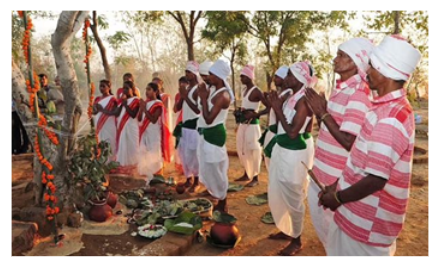
- The Sarna religion is a nature-worshipping faith that is also known as “Sarna Dharma” or “Religion of the Holy Woods”.
- Followers of the Sarna religion pray to trees and hills and believe in protecting forest areas.
- Their holy grail is “Jal (water), Jungle (forest), Zameen (land)”.
- Believers of Sarna faith do not practice idol worship, nor do they adhere to the concept of the Varna system, heaven-hell, etc.
- The Sarna religion is practised by a majority of the tribal community in Jharkhand.
- The tribal community celebrates the Sarhul festival, which is the New Year festival, as part of the Sarna religion.
- The followers are largely concentrated in the tribal belt states of Odisha, Jharkhand, Bihar, West Bengal, and Assam.
More Information:
- Sarna followers are demanding to include ‘Sarna’ as a separate religion for indigenous people in the next census.
- Significance: Recognition as a separate religious community will enable better protection of their language and history.
Green Revolution and Beyond - Edukemy Current Affairs
In News: M S Swaminathan is no more. But his legacy remains with every student and scientist of agriculture. He is most widely known for working with Norman Borlaug to usher in the Green Revolution in India in the mid-1960s when India was facing back-to-back droughts.
Green Revolution was a necessity for India due to several pressing reasons.
- India was grappling with a severe food crisis during the 1960s, primarily driven by rapid population growth, inadequate agricultural productivity, recurrent droughts, and a heavy reliance on food imports.
- India was highly vulnerable to external pressures and political interference from food-exporting nations, particularly the United States, which often used food aid as a means of exerting diplomatic influence and leverage.
- India had a strong desire to attain self-sufficiency and ensure food security for its burgeoning population while simultaneously reducing poverty and malnutrition levels.
- India aimed to modernize its agricultural sector, making it more efficient, profitable, and competitive in the global market.
Green Revolution
The Green Revolution was a significant initiative aimed at enhancing the production and quality of food crops, particularly wheat and rice, in India. This was achieved by introducing various technological advancements such as high-yielding varieties of seeds, fertilizers, pesticides, irrigation, and mechanization.
Key Objectives:
- Achieving Self-Reliance and Food Security: One of the primary goals was to attain self-sufficiency in food production and reduce reliance on food imports.
- Improving Livelihoods: The Green Revolution sought to elevate the income and living standards of millions of farmers and rural residents, thereby reducing poverty and hunger.
- Modernizing Agriculture: Another objective was to modernize the agricultural sector, making it more efficient, profitable, and competitive on a global scale.
Key Features:
- High-Yield Variety (HYV) Seeds: The adoption of HYV seeds, developed by agricultural scientists like M. S. Swaminathan, played a pivotal role in increasing food production.
- Irrigation Methods: Various irrigation techniques, including tube wells, canals, dams, and sprinklers, were implemented to reduce dependence on rainfall and ensure a consistent water supply for crops.
- Mechanization: Major agricultural processes such as plowing, sowing, harvesting, and threshing were mechanized using tractors, harvesters, and drills, leading to reduced labor costs and increased efficiency.
- Chemical Fertilizers and Pesticides: The use of chemical fertilizers and pesticides helped enhance soil fertility and protect crops from pests and diseases.
- Double Cropping: The practice of cultivating two crops in the same field within a single year, known as double cropping, increased cropping intensity and overall yield.
- Expansion of Farming Areas: Additional land was brought under cultivation, particularly in semi-arid and arid regions, through the use of irrigation and HYV seeds.
Impacts of Green Evolution
- Increased Food Production: The adoption of high-yielding crop varieties and modern farming techniques led to a substantial increase in agricultural productivity. This increase in food production helped meet the growing global demand for food, making countries like India major agricultural producers.
- Reduced Food Imports: As a result of increased food production, India transitioned from a country heavily reliant on food imports to being a net exporter of various food grains like wheat and rice. This reduced the need for importing food and enhanced food security.
- Poverty Alleviation: The Green Revolution contributed to poverty reduction by raising the incomes of small-scale farmers. Higher crop yields and increased income levels helped many farmers improve their standard of living.
- Technological Advancements: The Green Revolution introduced farmers to new agricultural technologies, including improved seeds, fertilizers, and pesticides. These advancements not only boosted productivity but also promoted sustainable agricultural practices and greater efficiency.
- Rural Development: Increased agricultural productivity often leads to rural development. As farmers earn more income, they can invest in their communities, leading to improved infrastructure, education, and healthcare in rural areas. The Green Revolution in India, for example, stimulated rural development through infrastructure improvements.
- Reduction in Land Conversion: Higher crop yields resulting from the Green Revolution reduced the pressure to convert forests and natural habitats into agricultural land. This contributed to preserving biodiversity and curbing deforestation, which are crucial for environmental conservation.
- Economic Growth: The increased agricultural productivity driven by the Green Revolution has been linked to overall economic growth in many countries. Agriculture is a vital sector for economic development, and higher yields can have a positive impact on the entire economy.
Challenges brought by the Green Revolution
- Environmental Degradation: The extensive use of synthetic fertilizers and pesticides during the Green Revolution led to environmental problems such as soil degradation, erosion, and water pollution. The overuse of these chemicals can have long-term negative impacts on ecosystems and water quality.
- Loss of Biodiversity: The focus on high-yielding crop varieties like wheat and rice often resulted in the neglect of traditional and indigenous crops. This led to a loss of biodiversity and genetic diversity among crops, making agriculture more vulnerable to pests and diseases in the long run.
- Dependency on External Inputs: Modern agricultural technologies introduced during the Green Revolution, including fertilizers and pesticides, made some regions and communities dependent on costly external inputs. This dependency can be financially burdensome and susceptible to market fluctuations, affecting the economic stability of farmers.
- Social and Economic Inequalities: The benefits of the Green Revolution were not evenly distributed, leading to social and economic disparities among farmers, regions, and countries. Some farmers benefited significantly, while others struggled to adapt, leading to conflicts and tensions within communities.
- Displacement of Indigenous Crops: The emphasis on high-yielding varieties often displaced traditional crops and farming practices. This shift away from indigenous crops had cultural and nutritional implications, affecting the diversity of diets and local food traditions.
- Vulnerability to Pests and Diseases: The promotion of monoculture, where a single crop is grown extensively, increased the vulnerability of crops to specific pests and diseases. For example, the monoculture of rice and wheat made them more susceptible to outbreaks of pests like the brown plant hopper and diseases like wheat rust.
- Climate Change Vulnerability: The Green Revolution's focus on specific crop varieties and practices may not be well-suited to changing climatic conditions. Climate change poses new challenges for agriculture, requiring adaptation and the development of more resilient crop varieties.
Green Revolution 2.0
Green Revolution 2.0 represents a modern approach to agriculture with a focus on adaptability, sustainability, and food security in the face of changing climate and socio-economic conditions. Some key features of Green Revolution 2.0 include
- Biotechnology and Genetic Engineering: Green Revolution 2.0 leverages biotechnology and genetic engineering to create crops that are more resilient to climate change, pests, and diseases. Genetically modified (GM) crops are considered as part of the solution, with responsible adoption potentially leading to increased productivity and reduced environmental impact.
- Precision Agriculture: This approach integrates advanced technologies like GPS-guided tractors and drones to optimize resource use, including water, fertilizers, and pesticides. Precision agriculture enhances efficiency and minimizes the environmental footprint of farming practices.
- Sustainability: Green Revolution 2.0 places a strong emphasis on sustainable farming practices. It promotes techniques that preserve soil health, reduce chemical inputs, and minimize agriculture's environmental impact. Approaches such as organic farming, agroecology, and integrated pest management are encouraged.
- Diversification: In contrast to the original Green Revolution's focus on a limited range of staple crops, Green Revolution 2.0 advocates for crop diversification. Encouraging the cultivation of a wider variety of crops can improve nutrition, reduce the risks associated with mono-cropping, and contribute to biodiversity conservation.
- Holistic Approach: Green Revolution 2.0 recognizes that agriculture is more than just crop production. It takes a holistic view that includes aspects like soil health, food processing, marketing, and value addition. Integrated approaches address the entire food supply chain.
- Environmental Considerations: Efforts are made to mitigate the negative environmental impacts associated with modern agriculture, such as soil erosion, water pollution, and greenhouse gas emissions. Sustainable practices aim to minimize these detrimental effects on the environment.
- Adaptation to Climate Change: Given the challenges posed by climate change, Green Revolution 2.0 focuses on developing climate-resilient crop varieties and farming practices. These adaptations are designed to cope with changing weather patterns and extreme conditions, ensuring the sustainability of agriculture.

Share the article
Edukemy’s Current Affairs Quiz is published with multiple choice questions for UPSC exams
MCQ
Get Latest Updates on Offers, Event dates, and free Mentorship sessions.

Get in touch with our Expert Academic Counsellors 👋
FAQs
UPSC Daily Current Affairs focuses on learning current events on a daily basis. An aspirant needs to study regular and updated information about current events, news, and relevant topics that are important for UPSC aspirants. It covers national and international affairs, government policies, socio-economic issues, science and technology advancements, and more.
UPSC Daily Current Affairs provides aspirants with a concise and comprehensive overview of the latest happenings and developments across various fields. It helps aspirants stay updated with current affairs and provides them with valuable insights and analysis, which are essential for answering questions in the UPSC examinations. It enhances their knowledge, analytical skills, and ability to connect current affairs with the UPSC syllabus.
UPSC Daily Current Affairs covers a wide range of topics, including politics, economics, science and technology, environment, social issues, governance, international relations, and more. It offers news summaries, in-depth analyses, editorials, opinion pieces, and relevant study materials. It also provides practice questions and quizzes to help aspirants test their understanding of current affairs.
Edukemy's UPSC Daily Current Affairs can be accessed through:
- UPSC Daily Current Affairs can be accessed through Current Affairs tab at the top of the Main Page of Edukemy.
- Edukemy Mobile app: The Daily Current Affairs can also be access through Edukemy Mobile App.
- Social media: Follow Edukemy’s official social media accounts or pages that provide UPSC Daily Current Affairs updates, including Facebook, Twitter, or Telegram channels.



